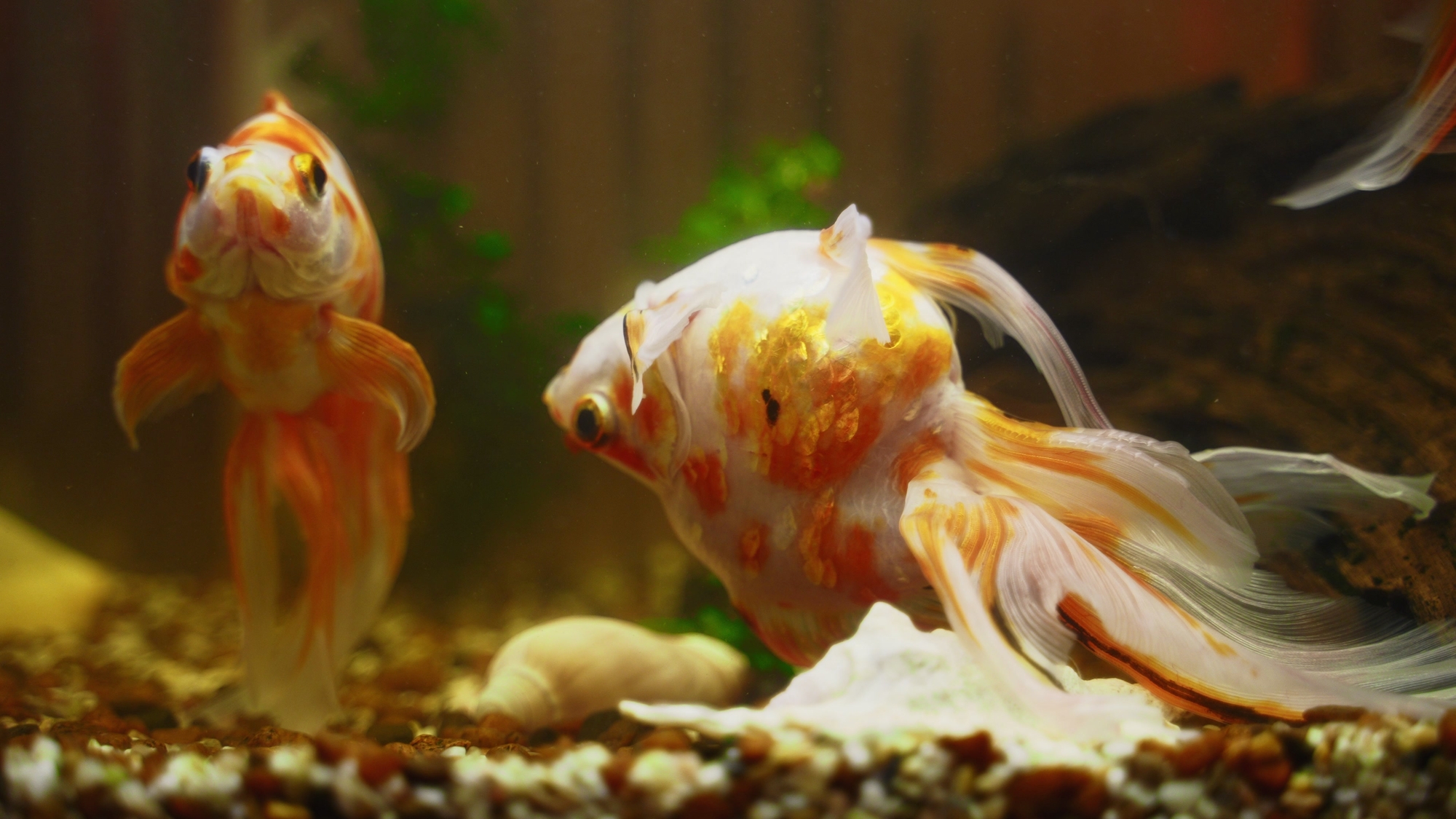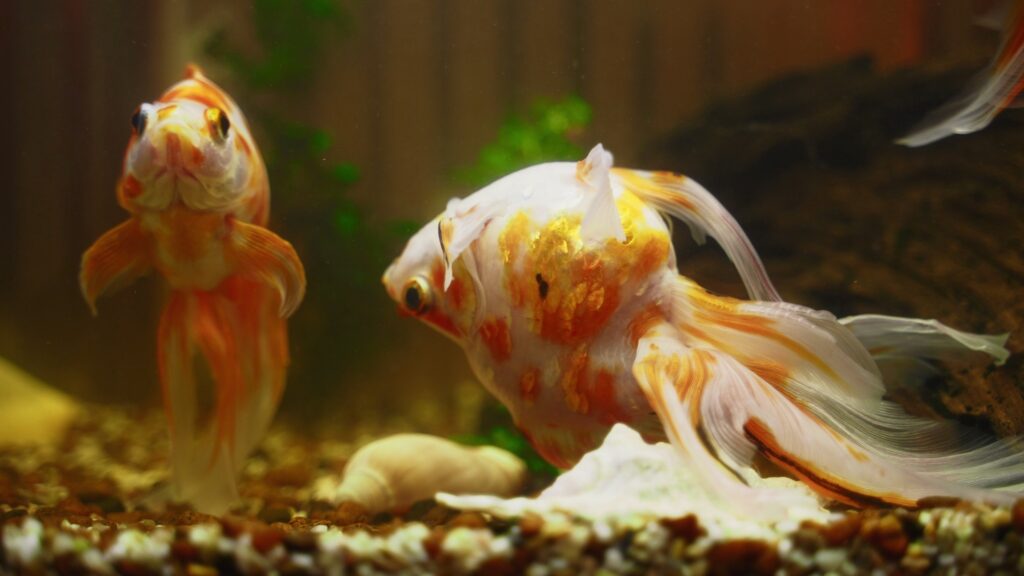Unfortunately, dying fish is a common problem that newbies to the fishkeeping hobby often encounter.
So, why do your fish keep dying and what can you do to prevent that from happening?
Read this informative article to find out what causes the unexplained loss of fish in tropical fish tanks and to learn how to solve the most common problems.
New Tank Syndrome
Many newbies to the hobby lose their fish because of what’s known as the “new tank syndrome.”
New tank syndrome refers to poor water quality in an uncycled fish tank and is one of the most common reasons for losing new fish. When you set up your new aquarium, make sure to allow sufficient time for the nitrogen cycle to fully complete before you add any fish or livestock to it.
If the tank is stocked too quickly, the environment and the biological filter media in your filtration system will not contain sufficient nitrifying bacteria to process the ammonia and nitrites produced by organic waste matter, including fish waste, uneaten food, plant debris, etc.
That leaves your aquarium water full of ammonia, nitrite, and nitrates that will very quickly poison your fish.
The Solution
If you have dead fish in a newly set-up tank that isn’t fully cycled, there are a few solutions you can try:
- Don’t add any new fish to the aquarium.
- Reduce the quantity of food you’re giving your fish to reduce water pollution.
- Carry out small percent water changes every day to stabilize the water parameters.
- Add a bacteria starter to the aquarium water to kick-start and accelerate the cycling process.
Keep testing the water using an aquarium water testing kit.
Once the levels of ammonia and nitrite are zero and the levels of nitrates are 20ppm or less, you can add a few more fish to the tank.
Before adding more, check the water chemistry to ensure that the filter system is not becoming overloaded again. If the ammonia level is still too high, perform another partial water change and allow more time for the colonies of beneficial bacteria to become established.
Incorrect Tank Size
Overcrowding your aquarium causes the tank inhabitants to become stressed.
Stress is a serious condition for aquarium fish species. Stress weakens the fish’s autoimmune system, leaving the fish more susceptible to disease than they would be in a more spacious tank. Fish keepers often buy a tank to suit the space they have available in their homes, rather than taking into account the size and activity of the fish they want to keep.
The fish for sale in your local fish store or online are usually juveniles that have a lot of growing to do. Some fish don’t appreciate too much company, whereas others are schooling fish that must live in groups to be happy and thrive.
The Solution
If you’ve had a few unexplained dead fish in your aquarium, do some retrospective research to find out more about the fish’s preferred habits.
For example, do the type of fish you keep like to live in solitude or are they happier in a school?
To make more space, you might need to upsize your tank or even pass on some of your fish to a friend or local fish store. However, if some of the dead fish freed up sufficient space for your remaining fish, simply avoid buying any more fish.
Transportation Issues
Many new fish die very soon after being introduced to their new home, and that’s often the result of the stress of transportation or poor acclimation.
When you buy a new fish, you don’t know how that fish was transported to the fish store. The fish might have made a long journey in overcrowded conditions, traveled in an unsuitable container, or the temperature in the truck carrying the fish was too hot or cold.
All of this can result in a sick fish that simply doesn’t make it.
The Solution
Before purchasing a new fish, ask the fish store when the fish was delivered and how long it’s been in their display tank. If the fish looks lively and is feeding well, chances are it’s traveled well and is not stressed.
Some fish stores will keep their new fish in a separate quarantine tank for a week or so before putting them up for sale. Remember to ask if that’s the case for the fish you’re thinking of buying.
Check the store’s returns policy before you take the fish home. Most reputable retailers will provide a refund if the fish dies within 24 hours of purchase.
Poor Acclimation

Poor acclimation is a common cause of fish deaths, especially in species that are highly sensitive to changes in water conditions.
A rapid temperature change is a common cause of problems for new fish, as are incorrect water parameters. Again, most fish prefer particular pH and water hardness levels, so ensure that the levels in the tank are similar to those in the fish’s transport bag before introducing your fish to your aquarium.
There are several methods of acclimation that you can use, so research them thoroughly before you bring your fish home and take time to acclimate your new fish to their new home.
Overcrowding
Overcrowding a community tank is a common newbie error that can result in dead or sick fish.
Overcrowding your aquarium causes three major problems that can affect the health of your fish:
- The nitrifying bacteria in the tank cannot cope with the amount of fish waste produced, resulting in poor water quality and an ammonia spike.
- The fish become stressed and sick because there are insufficient hiding places, especially if you have semi-aggressive species in the community.
- Shy fish might struggle to get enough food in a crowded tank.
The Solution
Don’t cram too many fish into your tank!
If you have too many fish, you should either buy a larger tank or try to offload some of your stock to a friend or your local fish store.
As a general rule, you should allow one inch of fish length per gallon of water in the tank. However, remember that some species need more space to feel comfortable and safe.
Incorrect Water Changes
Even relatively harmless nitrate can become a problem if levels are allowed to get too high. So, to control nitrate levels and keep your tank water clean and healthy for your fish, you must perform regular water changes every week to two weeks, depending on your stocking levels and the size of your tank.
Most tropical fish tanks need a water change of around 20% to 30%. However, many inexperienced aquarists make the mistake of changing too much water, which removes large numbers of nitrifying bacteria that causes the “new tank syndrome.”
Changing too much water in one go effectively sends the aquarium into shock, often causing massive fish kills.
The Solution
If you’ve made the mistake of changing too much water and some of your fish have died, the best thing to do is treat your tank as if it’s back in cycling mode.
Test the water every day, add more beneficial bacteria to the tank, and carry out small, regular water changes of around 10% until the water parameters become stable again.
Resist the temptation to add more new fish to the tank until the environment has stabilized again.
Unstable Water Parameters
As previously mentioned, many fish species are highly sensitive to changes in water conditions.
An aquarium is effectively an enclosed environment, and you are solely responsible for managing the water parameters and oxygen levels. Your fish will be happy, healthy, and thriving if the water condition is balanced.
The Solution
To make sure that your fish tank remains healthy for your fish, use an aquarium water testing kit every week to rule out the guesswork.
If the pH level is too low or too high, use a pH buffer to correct that, adjust salinity levels if necessary, and consider using RODI water if your tap water is too hard or soft for your fish.
Temperature Shock
Even hardy fish species can be vulnerable to water temperature shock, and most can only thrive in a relatively narrow temperature range. Sudden water temperature changes can stress your fish, leaving them vulnerable to many potentially fatal fish diseases.
Tropical fish cannot survive for long periods in cold water, so ensure the temperature of your tank is suitable for the fish.
The Solution
There are several things you can do to keep the tank temperature stable:
- Keep the tank away from direct sunlight.
- Don’t place the tank next to a cooling or heating vent.
- Restrict aquarium lighting to a maximum of ten hours per day.
- Keep the tank out of drafts.
- Check regularly that the tank heater is functioning correctly.
Invest in a high-quality, reliable, digital aquarium thermometer and check the tank water temperature every day at the same time to ensure it’s stable.
Overfeeding Your Fish
Aside from ammonia poisoning, overfeeding your fish is just about the most common reason for fish deaths in a tank.
Greedy feeders can suffer from conditions such as constipation and bloat, which can kill if not remedied promptly. Uneaten food will quickly decompose, producing ammonia and nitrites that will pollute your clean water.
The Solution
Offer your fish only what they will clear up completely in two to three minutes. Feed your fish small feeds several times a day rather than giving them one large feed.
Be sure to use an aquarium vacuum cleaner to remove leftover food from the substrate before it has a chance to decompose and overload your filter.
You may also want to consider adding a few bottom-feeding species, such as snails and shrimp, to the tank to help clear away uneaten food.
Poor Tank Cleaning Practices
Whether your keep tropical or coldwater fish, you must keep your tank clean. Dirty water is more likely to harbor parasites and bacteria that could attack your fish, and thick growths of algae make the tank look unsightly.
If the water quality in the aquarium is very poor and the ammonia level is high, premature death in most fish species is likely.
The Solution
In addition to performing weekly water changes to keep the ammonia level down, remember to also vacuum around the base of plants, under internal filter boxes, and underneath decorations.
It’s also a good idea to add a water conditioner to the aquarium to boost your fish’s health and immune systems. If you keep living plants, you’ll need to trim away dead leaves and broken stems.
Once a month or so, rinse the filter media to remove any sludge that might prevent the water from circulating through the filter system. You’ll also need to replace the media periodically by the manufacturer guidelines.
Bacterial Infection and Diseases
When you add new fish, aquatic plants, and unwashed decorations to your fish tank, you risk introducing parasites, diseases, and bacteria into the environment. Even dirty fishnets and your aquascaping tools can contribute to the spread of diseases if you don’t clean your equipment properly after use.
Premature death, an unexpected illness, and an increased mortality rate among your freshwater fish can often be caused by an accidental introduction of diseases.
The Solution
You can reduce the risk of bacterial and parasitic infection affecting your fish by placing new fish and living plants in a quarantine tank for a few weeks before introducing them to your established community tank.
That way, you can observe your new purchases to see if they show any signs of disease. It can also be helpful to dose the quarantine tank with a broad-spectrum antibacterial and antiparasitic medication to kill off any problems before exposing your existing fish to the newcomers.
Before adding new plants or decorations to your tank, rinse them thoroughly in old tank water and inspect underneath plant leaves carefully for parasites that might be hidden.
Remember to always sanitize aquascaping tools and fishnets immediately after every use.
Stress
Stress is probably the most common cause of an increased mortality rate in aquarium fish. Many external causes can trigger high fish stress levels including:
- Poor water quality.
- An attack by aggressive tank mates.
- Unstable water conditions.
- Overcrowding the tank with fish and plants.
- Disturbance outside the tank, such as loud noises, sudden movements, children tapping on the glass, and more.
The Solution
Ensure the water quality in your tank remains stable and is correct for your fish, choose compatible tank mates, include plenty of hiding places and dense planting to provide a haven for shy fish, and place your aquarium in a quiet and calm spot.
In addition, we’d recommend that you don’t rearrange your tank’s interior radically, which can cause stress for territorial species that like to stake out a patch to call their own.
Final Thoughts
Most aquarium fish deaths happen due to errors made by newcomers to the hobby. You can avoid making many of these mistakes by reading some of the fish care articles on our website.
The most common causes of fish deaths are poor water quality, “new tank syndrome,” and stress. Those causes are likely to blame if you have problems in your aquarium.
To maintain a healthy aquarium, remember to monitor the water conditions in your fish tank, keep the tank clean and well-maintained, and research your fish carefully so that you understand their requirements.
If you do all these things, you’ll be rewarded with a tank full of happy, thriving, and healthy fish.












